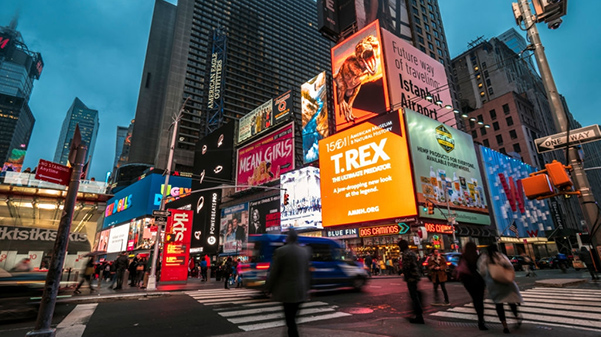We often hear the debate of which is better for marketing, billboards, or social media. The answer is that it depends on your specific campaign and what you are trying to achieve.
Since nearly the advent of motion pictures in the early 20th century, cinema advertising has been a popular and effective way for businesses to get their messaging to consumers. And even in the age of streaming, movie theaters continue to offer businesses access to captive audiences ready to be persuaded.
Whether you’re actively pursuing options for a cinema place-based media campaign or simply curious about how it works, here’s everything you need to know about getting your ads to play in a theater near you.
What Is Cinema Advertising?
Cinema advertising is the practice of movie theater advertising. A type of out-of-home advertising, it uses various technologies and appropriates various locations within movie theaters to feature advertisements across a variety of formats, from static posters to digital and video ads.
Common types of cinema advertising examples include:
- Video ads – Video ads or a cinema commercial would play before the movie trailers start to roll. Typically, they’re no different from commercials that run on television.
- Slideshow ads – These are the silent, still advertisements that play on the screen while you’re filing into the theater and picking your seat.
- Kiosk ads – Kiosk ads appear on movie theater kiosks. They’re usually located in the lobby and can feature digital or static options.
- Standees – These are large, free-standing advertising displays. They typically resemble large posters.
- LED screens – The silver screen isn’t the only screen audiences encounter when they go to the movies. Many theaters offer options for digital advertising on smaller LED screens located throughout the building.
Cinema Advertising Trends
Although the past couple of years have not been a shining moment for cinemas or cinema advertising, there is some bounce-back in cinema advertising trends as audiences begin returning to movie theaters.1
Anxious audiences of cinema goers represent a ready market for advertisers hoping to capitalize on the appeal of the big screen. As new innovations in how movie theaters operate continue to develop, like touchless systems for ticketing and ordering concessions, so too will new advertising opportunities.
Cinema Advertising Pros & Cons
When you consider the popularity of moviegoing and the variety of options available for advertising, it’s easy to see what makes ad cinema such an attractive choice for businesses. But the reviews can’t all be raves. What are the pros and cons of cinema advertising? Let’s take a closer look at that now.
The Upside
A unique and versatile advertising method, cinema advertising isn’t lacking in the plus column. Here are just some of the biggest boons:2
Pro: It Offers a Captive, Receptive Audience in a Distraction-Free Environment
Many types of advertising enable you to meet consumers where they are, whether that’s the supermarket, the bus stop, or the football stadium. But few of them offer you access to an audience already primed to receive your message in quite the way cinema advertising does.
- Audiences expect advertisements – Cinema ads are as recognizable a part of the moviegoing experience as licorice, popcorn, and previews. This could mean that audiences are less likely to be annoyed or turned-off by your ad as opposed to in-stream advertising that often interrupts a viewer’s show or movie on streaming platforms.
- Audiences are more receptive – Although there’s something to be said for the element of surprise, when your audience is already expecting your ad, they’re more likely to engage with it.
- Audiences aren’t distracted – Let’s face it: a darkened movie theater might be one of the last settings in the world where the screen people are most likely to be looking at isn’t the one in their hand. They’re also free from other visual distractions and less likely to be engaged in conversation.
Pro: Better Impressions
When you combine audience expectation, receptivity, and the movie theater environment, you boost the impressions your ads receive. This can make cinema advertising a more cost-effective—if not less-expensive—option for many brands.
Internet ads or even traditional TV spots, are easily—and frequently—ignored by consumers, who only have to close the ad, change the channel, or walk out of the room to avoid it.3 Cinema advertising can help alleviate that problem.
Pro: Everything’s Better On the Big Screen
One of the aspects that sets cinema advertising apart from other kinds of advertising, especially if you run a video ad that plays before the movie, is the opportunity it gives you to capture some of the larger-than-life enchantment of the silver screen.4 After all, they don’t call it movie magic for nothing.
And while the allure of the big screen can’t be overstated, the moviegoing experience isn’t contained exclusively to the theater itself. Audiences surrender themselves to the glitz and glamour of the movies the second they enter the movie house, so don’t underestimate the power of:
- Lobby kiosks – Grab the attention of consumers in the lobby while they wait to meet friends or purchase concessions.
- LED Screens – LED screens draw the eye and capture consumers’ attention. You can engage with your audience while they’re waiting in the ticket line or using the restroom.
- Standee posters – Standees are large enough to stand out and portable enough to go anywhere, making them an ideal way to advertise to consumers who are already looking.
Pro: Better Demographic Targeting
Cinema advertising offers unique insights into the precious demographic information that advertisers live for. When you use cinema ads, you can capitalize on consumer information like age, gender and location:
- Studies show that the most frequent moviegoers are between 18 and 45.5
- Although the numbers skew somewhat differently among younger viewers, in general, most moviegoers are male.6
- Most movie theaters service patrons who live within a ten-mile radius.
The Downside
“If you look for perfection, you’ll never be content,” Tolstoy wrote. Nevertheless, when it comes to advertising, even the most effective methods can fall short—and cinema advertising is no exception. Here are a few of the biggest drawbacks:2
Con: It’s Expensive
From the price of the ticket to the cost of a box of Junior Mints, these days, nothing about going to the movies is cheap—and that includes advertising. In many cases, you can expect to pay top dollar if you want to see your video ad in the limelight.
The cost of screening your video ad will vary depending on factors like duration and the number of screens it shows on. Other factors like the prerogative of individual theaters and popular interest in specific films can also play a part. So, it’s best to inquire with theaters directly about their rates. That said, here’s a good estimate of what it’ll cost to book a screen for your video ad:7
- For a 15-second ad, expect to pay between $1,000 and $2,000 dollars.
- 30-second ads will run you between $2,000 and $3,000 dollars.
- You’ll pay no less than $3,000 and up to $4,000 dollars or more for 60-second ads.
If a video ad is beyond your budget, other cinema advertising options like standee ads or even digital kiosk ads can be a less pricey way to go.
Con: Audiences Might Not Remember Your Ad
Another drawback of cinema advertising is the obstacles it can pose to consumer recall. Who hasn’t left the theater at the end of the movie, unable to remember which movies were previewed beforehand—let alone what ads they saw?8
Audiences go to the movies to enjoy the experience and get lost in the story. This can sometimes mean your ad gets lost in the sensory onslaught.
Con: Audiences Might Avoid Your Ad Altogether
Even if they can’t close out or fast forward through it, audiences aren’t without options for dodging your ad. Everyone but first-timers know how to time their arrival so that they miss all the pre-movie business, including your ad spot.
And even if they’re milling around in the lobby before or after, there’s nothing forcing them to look at your kiosk ad or standee poster.
Con: It Can Sometimes Be Difficult To Reach Your Target Audience
Reaching your target audience with cinema ads can be difficult. Movie theaters cater to audiences composed of as many kinds of people as there are genres of film. This means successful cinema advertising has to be able to reach everyone, from parents dragging their kids to a Pixar flick to middle-aged adults lining up for the latest James Bond spectacle.
The diversity and unpredictability of moviegoing audiences can sometimes leave businesses with two options: craft generic ads in an attempt to appeal to more people, or something more specific that misses its target.
Find Your Audience With True Impact Media
Ever wish that finding the right solutions to all of your OOH advertising needs were as easy as a trip to the movies? With True Impact Media, it can be! Whether you are looking into mall advertising, bar advertising, or stadium advertising, we have you covered with all the information you need to get your place-based media campaign up and running.
As big fans of OOH advertising, we believe that launching a campaign shouldn’t be a difficult and complicated endeavor. That’s why we built our innovative platform—to help businesses of all sizes achieve their OOH advertising goals. We’re changing the way OOH operates by:
- Simplifying and streamlining the searching and buying process
- Offering data-driven placement services
- Helping you manage and track vendors and quotes
Ready to experience the exciting world of OOH advertising? Join us today!
Sources:
- Thedrum.com. Cinema Advertising Post-Pandemic: What Does the Future Hold For the Silver Screen? https://www.thedrum.com/news/2021/04/16/cinema-advertising-post-pandemic-what-does-the-future-hold-the-silver-screen
- Linchpinseo.com. Cinema and Movie Theater Advertising Guide to Increase Brand Awareness. https://linchpinseo.com/guide-to-advertising-in-cinemas-and-movie-theaters/
- Oneday.agency. The Power of Cinema Advertising in 2021. https://oneday.agency/blog/the-unique-power-of-cinema-advertising-in-2021
- Linkedin.com. A Complete Guide to Cinema Advertising. https://www.linkedin.com/pulse/complete-guide-cinema-advertising-all-you-need-know-advertising
- Statista.com. Frequency of Going to the Movies in the U.S. By Age. https://www.statista.com/statistics/538259/frequency-going-to-the-movies-age-usa/
- Statista.com. Frequency of Going to the Movies in the U.S. By Gender. https://www.statista.com/statistics/538239/frequency-going-to-the-movies-gender-usa/
- Smallbusiness.chron.com. Advantages and Disadvantages of Advertising in Cinemas. https://smallbusiness.chron.com/advantages-disadvantages-advertising-cinemas-21521.html
- Smallbusiness.chron.com. The Disadvantages of Cinema Advertising. https://smallbusiness.chron.com/five-advantages-using-celebrities-advertising-34394.html




